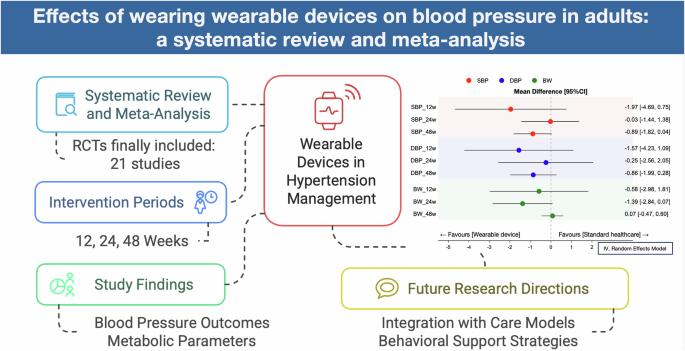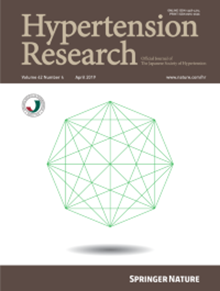促进身体活动的可穿戴设备对成人血压的影响:系统回顾和荟萃分析。
IF 4.6
2区 医学
Q1 PERIPHERAL VASCULAR DISEASE
引用次数: 0
摘要
高血压影响全球超过40亿人,是心血管疾病的主要危险因素。改善身体活动是控制高血压的有效方法,近年来人们对使用可穿戴设备促进身体活动产生了很大的兴趣,这种设备越来越受欢迎,但在许多国家,身体活动水平的改善仍然不足。本系统综述和荟萃分析调查了使用可穿戴设备的干预措施是否对成人血压有有益影响。按照PRISMA 2020指南并在PROSPERO注册(CRD42023442506),我们检索了PubMed、MEDLINE、Cochrane Library和IchuShi-Web,确定了21项随机对照试验,包括高血压、2型糖尿病或超重/肥胖患者。干预措施从12周到48周不等,使用计步器、活动追踪器和智能手表。随机效应荟萃分析显示,这些干预措施在任何干预时间(12周、24周或48周)都没有产生统计学上显著的收缩压或舒张压改善。同样,次要结果(体重、空腹血糖和血红蛋白A1c)也没有统计学上的显著改善。异质性高低取决于结果和干预期。这些发现表明,目前仅使用可穿戴设备促进身体活动的直接干预证据不足以建立有临床意义的血压和相关代谢参数的改善。未来的研究可能需要将可穿戴技术整合到综合护理模式中,将有针对性的反馈和教育与行为支持策略相结合,而不是仅通过监测直接干预。本文章由计算机程序翻译,如有差异,请以英文原文为准。

Effects of physical activity-promoting wearable devices on blood pressure in adults: a systematic review and meta-analysis
Hypertension affects more than 4 billion people worldwide and is a major risk factor for cardiovascular disease. Improving physical activity is an effective way to manage hypertension, and there has been a lot of interest in the use of wearable devices for promoting physical activity, which have become increasingly popular in recent years, but in many countries, improvements in physical activity levels remain inadequate. This systematic review and meta-analysis investigated whether interventions using wearable devices have a beneficial effect on blood pressure in adults. Following PRISMA 2020 guidelines and registered with PROSPERO (CRD42023442506), we searched PubMed, MEDLINE, Cochrane Library, and IchuShi-Web, identifying 21 randomized controlled trials including participants with hypertension, type 2 diabetes, or overweight/obesity. Interventions ranged from 12 to 48 weeks using pedometers, activity trackers, and smartwatches. Random-effects meta-analysis showed these interventions did not produce statistically significant improvements in systolic or diastolic blood pressure at any intervention duration (12, 24, or 48 weeks). Similarly, no statistically significant improvements were found in secondary outcomes (body weight, fasting blood glucose, and Hemoglobin A1c). Heterogeneity varied from low to high depending on outcome and intervention period. These findings indicate that evidence of direct intervention using wearable devices for promoting physical activity alone is currently insufficient to establish clinically meaningful improvements in blood pressure and related metabolic parameters. Future research may need to integrate wearable technology into comprehensive care models that combine targeted feedback and education with behavioral support strategies, rather than direct intervention through monitoring alone.
求助全文
通过发布文献求助,成功后即可免费获取论文全文。
去求助
来源期刊

Hypertension Research
医学-外周血管病
CiteScore
7.40
自引率
16.70%
发文量
249
审稿时长
3-8 weeks
期刊介绍:
Hypertension Research is the official publication of the Japanese Society of Hypertension. The journal publishes papers reporting original clinical and experimental research that contribute to the advancement of knowledge in the field of hypertension and related cardiovascular diseases. The journal publishes Review Articles, Articles, Correspondence and Comments.
 求助内容:
求助内容: 应助结果提醒方式:
应助结果提醒方式:


